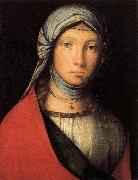Wholesale Oil Painting Reproductions No Minimum and Door to Door! |
|||||||||||
|
|
|||||||||||

|
|||||||||||
|
|
|
||||||||
All BOCCACCINO, Boccaccio Oil Paintings |
||||||||
|
|
||||||||
|
|
||||||||
|
Artist Introduction: Italian painter, Cremonese school (b. before 1466, Ferrara, d. 1524/25, Cremona)
He is first recorded in 1493 in Genoa, where he contracted to paint the high altarpiece (untraced) for S Maria della Consolazione. In 1497 he was extracted from prison in Milan by the agent of Ercole I d'Este, Duke of Ferrara, and worked for the Duke in Ferrara until 1500. Perhaps as a consequence of having killed his common-law wife he then left, presumably for Venice, where he is recorded as residing in 1505. A fresco in Cremona Cathedral is dated 1506. |
||||||||
|
|
||||||||
|
Gypsy Girl Painting ID:: 29901 |
mk67
Panel
9 7/16x7 1/2in
Uffizi,Gallery
|
|||||||
Height Width |
INS/CM Quality |
|||||||
|
X |
| |||||||
|
|
||||||||
All Frans Hals Oil Paintings |
||||||||
|
|
||||||||
|
|
||||||||
|
Artist Introduction: 1580-1666
Frans Hals Galleries
In the field of group portraiture his work is equalled only by that of Rembrandt. Hals's portraits, both individual and group, have an immediacy and brilliance that bring his sitters to life in a way previously unknown in the Netherlands. This effect, achieved by strong Baroque designs and the innovative use of loose brushstrokes to depict light on form, was not to the taste of critics in the 18th century and the early 19th, when his work was characterized as lazy and unfinished. However, with the rise of Realism and, later, Impressionism, Hals was hailed as a modern painter before his time. Since then his works have always been popular. |
||||||||
|
|
||||||||
|
|
Gypsy Girl Painting ID:: 59193 |
Frans Hals. Gypsy Girl. 1628-30. Oil on wood, 58 x 52 cm. Mus??e du Louvre, Paris. |
||||||
Height Width |
INS/CM Quality |
|||||||
|
X |
| |||||||
|
|
||||||||
All Frans Hals Oil Paintings |
||||||||
|
|
||||||||
|
|
||||||||
|
Artist Introduction: 1580-1666
Frans Hals Galleries
In the field of group portraiture his work is equalled only by that of Rembrandt. Hals's portraits, both individual and group, have an immediacy and brilliance that bring his sitters to life in a way previously unknown in the Netherlands. This effect, achieved by strong Baroque designs and the innovative use of loose brushstrokes to depict light on form, was not to the taste of critics in the 18th century and the early 19th, when his work was characterized as lazy and unfinished. However, with the rise of Realism and, later, Impressionism, Hals was hailed as a modern painter before his time. Since then his works have always been popular. |
||||||||
|
|
||||||||
|
|
Gypsy Girl Painting ID:: 88325 |
between 1628(1628) and 1630(1630)
Medium Oil on wood
cyf |
||||||
Height Width |
INS/CM Quality |
|||||||
|
X |
| |||||||
|
|
||||||||
|
Prev Next
|
||||||||
|
|
||||||||
|
Related Paintings to Frans Hals :. |
||||||||
|
|
||||||||
|
CONTACT US |



